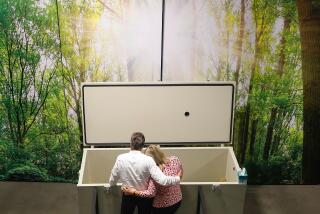RETURN OF THE MUMMY : A small company has revived the Egyptian practice of preserving bodies for posterity. Among its offerings: a choice of sarcophagus.
- Share via
Now when I die,
now don’t think I’m a nut.
Don’t want no fancy funeral ,
just one like old King Tut.
--Steve Martin,
“King Tut”
Somewhere in Utah, a dead parrot named Eric floats in a stainless steel vat of carbonated water, borax and other chemicals.
When sufficiently marinated, the ex-bird will be coated with polyurethane, wrapped beak to toe in bandages and sealed inside a small metal sarcophagus. A few years later, his owner will join him--as will other petrified humans and pets--and they’ll spend all eternity in an abandoned Utah silver mine.
The modern mummies are clients of Summum, a Salt Lake City company that has revived the ancient Egyptian practice of preserving bodies for posterity. For a minimum of $32,000 (less if you’re a parrot), Summum will turn you into a museum-quality corpse.
“Future generations can go in and visit you and see what you were like,” says aspiring mummy Lydia Campuzano, 31, of Santa Ana, whose bird apparently felt likewise. A week after she told Eric about Summum, he died, “so he must have wanted to be mummified.”
The man behind the mummies is Irvine aerobics instructor Summum Bonum Amen Ra (Corky for short). Ra, 48, formerly Claude Nowell, got into the rag-wrapped corpse business by way of a giant wooden pyramid, a little wine and a deceased Doberman.
His tale unfolded in 1975 with a family bet about Utah liquor laws: Nowell’s relatives said the state would never allow the manufacture of alcohol; he decided to prove them wrong. He later discovered a legal loophole permitting production of wine for religious ceremonies and opened Summum, Utah’s first winery, housed inside a 1,600-square-foot pyramid in Salt Lake City.
The Egyptian motif was a gimmick, but a fateful one. As Nowell and some friends meditated inside the building one day, he flashed on the idea of mummification. “Pyramids, mummies--it all tied together,” he recalls.
So he teamed with Salt Lake mortician Ron Zefferer, 45, and developed a patented process for immortalizing corpses. Mummy No. 1 was Nowell’s dead Doberman, Butch; No. 2 was Oscar the cat, a casualty of feline leukemia.
Pooch and kitty went on display at the winery; Nowell and Zefferer went public. To promote their service, the mummy meisters changed their names (Nowell to Ra, the Egyptian sun god; Zefferer to Temu, which translates as “the finish”) and granted interviews to such publications as People magazine, the Wall Street Journal and Cremation Chronicles.
Mummification isn’t weird, they would tell reporters: Even Jesus was a mummy. (As evidence, they note that the Bible says Christ’s body was prepared for burial with “about a hundred pounds” of myrrh and aloe--and extensive wrapping in linens.)
The pair also attended a funeral industry convention at Caesars Palace in Las Vegas, where they ran into John A. Chew, a mortuary sciences professor in Boca Raton, Fla. Chew, 60, had been fascinated with ancient Egypt since childhood, after a museum curator let him dust a few mummies, and had been tinkering with his own mummification recipes.
Summum put Chew in charge of its human mummification division, which is now based at Boca Raton’s Lynn University. (Animals still go to Salt Lake City.) So far, however, he hasn’t had much business. None of the company’s 139 clients has had the good graces to die.
*
Summum customers range in age from late 20s to mid-50s and include a chef, a nurse and a celebrity musician whose identity “would just amaze people” if the company were at liberty to release it, Ra says. One in six mummies-in-waiting is a Californian.
When somebody finally succumbs, the body will be flown to Florida, where Chew and his students have been experimenting on cadavers. “There has been no breakdown of tissue at all,” says the professor, whose mummification equipment includes hieroglyphic-covered vats, scalpels and germ-proof suits.
The method he uses borrows heavily from ancient Egypt--except the part about removing the brain through the nostrils. “We tried that, but it’s pretty hard,” says Chew. Instead, Summum “injects a chemical preservative into the cranial vault,” which converts the brain into an “almost plastic-like” lump.
Other internal organs are steeped in Summum’s secret sauce, then inserted back in the body. Then the corpse is painted with polyurethane (Egyptians used hot tar), wintergreen and wine (Summum, of course), and wrapped in a cocoon of cloth and fiberglass gauze.
The procedure takes up to 70 days, during which a team of Chinese artisans (the Egyptians used Egyptian artisans) works on the sarcophagus. Customers have a choice of styles: Art Deco, traditional Egyptian or custom-made. The price tag for the latter--which can include decorative gold inlay and eye sockets drilled out for sapphires--runs upwards of a half-million dollars. “There is no limit to extravagance,” Ra has said.
Among the designs on order: an Oscar statue with the face of the deceased; a woman in a wedding dress; and, for an attorney who lives in Salt Lake City, a three-piece suit. Other customers have asked to be immortalized holding soccer balls, wrenches, autographed baseball bats, microphones and the Beatles’ White Album.
Once the sarcophagus is ready, the body is slipped inside, argon is pumped in to replace the oxygen and the seal is welded shut. Argon, an inert gas, helps prevent the mummy from decomposing.
“It sounds like it ought to work,” says Michael Zimmerman, a pathologist and mummy expert at Hahnemann University in Philadelphia, who was asked by The Times to review Summum’s methods. “The (corpse) should last indefinitely.”
In a 1988 column about Summum, humorist Dave Barry agreed: “This is, of course, the same technique used in making fruitcakes, which are so well-preserved that they can be passed as gifts from person to person for decades and yet still taste as good as when they were first made, if anybody ever actually ate one.”
But Barry doubted the company’s claim that mummification “will allow you to leave this life in as beautiful a manner as when you came in. . . . Most of us came into this life looking like large, hairless rodents that had just been pulled out of a vat of transmission fluid.”
*
So, what are the advantages of being petrified for posterity? Ancient Egyptians did it because they believed their souls would someday return to their bodies.
Modern mummies, says Ra, seem motivated more by vanity: “When you’re buried in a cemetery, you’re covered with dirt and forgotten. With mummification, you’re remembered.”
Parrot owner and aspiring mummy Campuzano likes the idea of going out in style. “It’s the burial of kings,” she says.
Other customers apparently have a self-preservation instinct that extends beyond death. “The thought of being stuck in a coffin and rotting in the ground seems kind of unsettling,” says Bernie Beichert, 34, of Santa Ana.
To keep worms at bay, he and the other future mummies pay about $130 a month for life insurance policies that cover costs.
Ra says Summum is the beneficiary of insurance policies worth $50 million but “I may be dead before it ever really starts to turn a good profit.”
Until then, most of the bills are paid by Summum’s winery, which grosses $1 million a year selling sacramental Chardonnays for up to $360 a bottle. The company has also begun pushing pet mummification, which brings in $4,000 per animal--minimum. And it plans to sell mausoleum space--complete with viewing windows of 6-inch-thick glass--in an abandoned mine in the mountains of southern Utah.
Ra, meanwhile, has resigned from Summum so he can promote mummification without appearing to do so for monetary gain. He lives off a family trust, aerobics lessons and a “small salary” from running a charity for the homeless that collects money through gumball machines.
He is also chief apostle of the Summum philosophical society, which claims several dozen members. The teachings of Summum recommend--not surprisingly--imbibing certain Utah wines, known as “publications of liquid knowledge,” and, of course, mummification.
That accounts for many of Summum’s customers. Others have been drawn in by stories about the company, Ra says. But recruitment is slow. Although Summum brochures predict that “by the year 2001, mummification will account for over half of all funeral business,” Chew concedes the practice “will never be big.”
Ra, on the other hand, notes that the funeral industry thought cremation wouldn’t catch on, either: “And we all know what happened with that.”
As mummies-to-be see it, there’s plenty of room for alternative ways to die.
Says Campuzano: “I’m not into dirt and I don’t want to be engulfed in flames. . . . I’ve been hanging around to see what else came up.”
More to Read
Sign up for Essential California
The most important California stories and recommendations in your inbox every morning.
You may occasionally receive promotional content from the Los Angeles Times.










